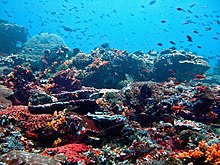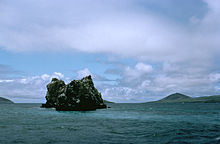



A reef is a ridge or shoal of rock, coral, or similar relatively stable material lying beneath the surface of a natural body of water.[1] Many reefs result from natural, abiotic (non-living) processes such as deposition of sand or wave erosion planing down rock outcrops. However, reefs such as the coral reefs of tropical waters are formed by biotic (living) processes, dominated by corals and coralline algae. Artificial reefs, such as shipwrecks and other man-made underwater structures, may occur intentionally or as the result of an accident. These are sometimes designed to increase the physical complexity of featureless sand bottoms to attract a more diverse range of organisms. Reefs are often quite near to the surface, but not all definitions require this.[1]
Earth's largest coral reef system is the Great Barrier Reef in Australia, at a length of over 2,300 kilometres (1,400 miles).